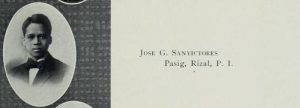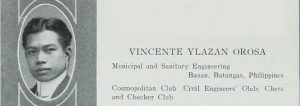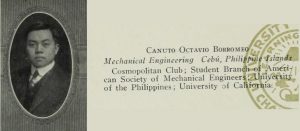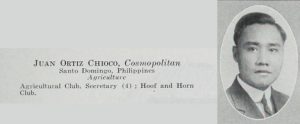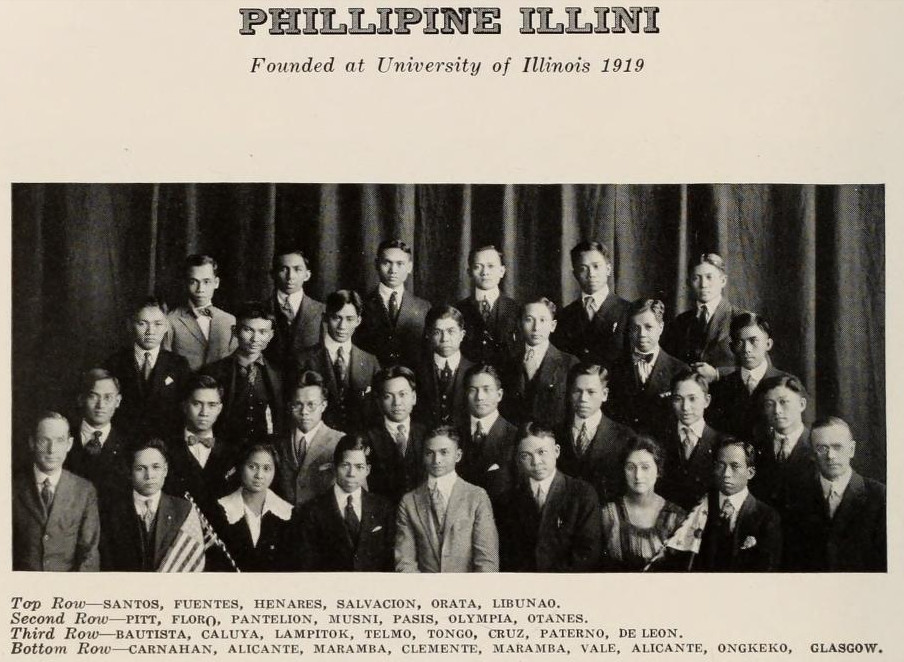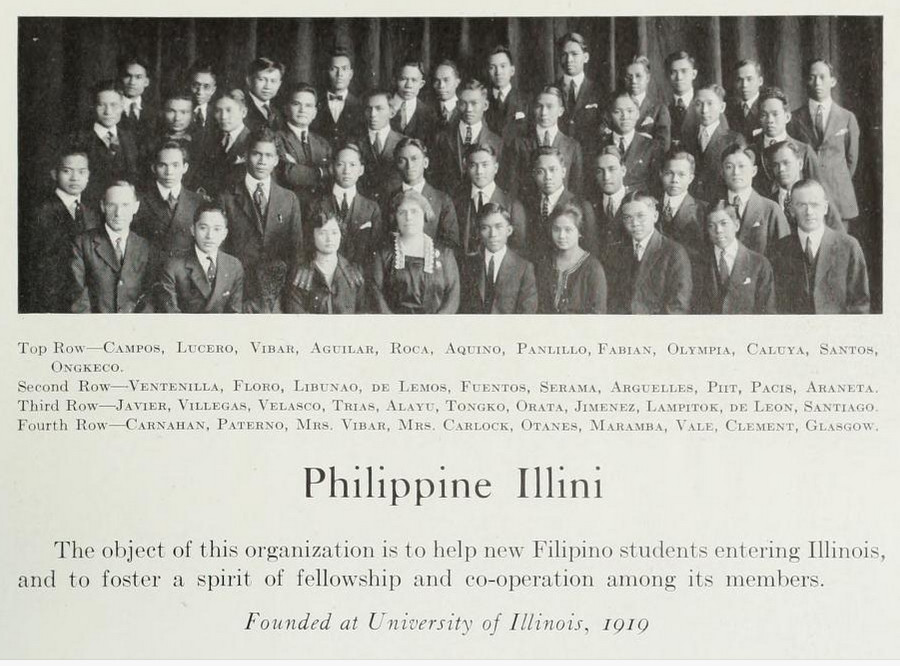Since at least 1905, Filipino students have been attending the University of Illinois. Early Filipino Illini have included agriculturalists, architectural engineers, business administrators, chemical engineers, chemists, civil engineers, dancers, educators, electrical engineers, English instructors, governmental administrators, history instructors, lawyers, mechanical engineers, military officers, mining engineers, municipal and sanitary engineers, musicians, political scientists, politicians, and transfer students too.
- A 1921 Illio group photo of the Philippine Illini student organization, found in Record Series 41/8/805.
Read on to learn about early Filipino Illini!
Early Illini in the Philippines
Before the first Filipino Illini came to campus multiple faculty members’ careers had brought them to the Philippines. Just a few years later, some Illinois graduates would begin their careers in research and instruction there too.
Faculty
At least two different faculty members of the military education program were involved in the Spanish American War (1898) and the Philippine American War (1898-1902). First, there was Major Herbert Howland Sargent (Military Science 1886-1887) who was professor for just one year when he was called for service in the War. During his service, Professor Sargent was stationed in Cuba in 1898 and in the Philippines from 1898 until 1901 and again in 1909. Some of his experiences can be read in his 1907 book The Campaign of Santiago de Cuba. In fact, he was recommended for brevets for meritorious services in the Philippines and Cuba. Later, before coming to campus, Major Edward W. McCaskey (University Brigade Commandant 1917 – 1918) was stationed in the Philippines from 1899-1902.
Beginning almost ten years later, at least two other faculty members began their careers at schools in the Philippines, before coming to Illinois. First, it was Professor Dudley Odell McGovney (Law, 1907–1908) who worked as a teacher of history and government in a normal school in Manila, from 1901 until 1903. From those experiences, he wrote two publications about the country. Professor McGovney published Civic Government in the Philippines in 1903 and Stories of Long Ago in the Philippines in 1906. Later, Horace Grove Deming (Chemistry Associate 1916-1918) was a Chemistry Professor at the University of the Philippines from 1911-1916, before taking his position at Illinois too.
Alumni in the Philippines
Between both Professor McGoveny’s time and Mr. Deming, at least one alumni’s career brought him to the Philippines multiple times for research. Mr. Robert Earl Richardson (M.A. Zoology, 1903) was an author of multiple papers concerning fish in Illinois and the Philippines. In particular, in 1908, he published Fishes from the Islands of the Philippine Archipelago. Later, in 1910, he published Checklist of the Species of Fishes Known from the Philippine Archipelago. A few years later, another two alumni began their careers as instructors in schools in the Philippines too. First, it was Frank Caleb Gates (A.B. Science 1910) who taught at the University of the Philippines from 1912-1915. Later, it was James Arthur Noon, (A.B. Science, 1913) who taught at an unidentified school in the Philippines (1913-1916) and he became a principal in 1916.
Early Filipino Illini
As early as 1905, the first Filipino students came to campus; however, many students began their studies at American high schools a few years earlier. Many students were graduates of top schools and they studied at other colleges or universities before coming to Illinois. Below, arranged by the date of their campus enrollment year, select Filipino student success stories outline how some early students participated in campus life, prior to the establishment of the student organization Philippine Illini (later Philippine Student Association) in 1919.
1905
- A 1908 Illio profile photo of Mr. Juan F. Hilario, found in Record Series 41/8/805.
Mr. Juan Fernando Hilario, (LL.B. 1908) of Batangas, came to Illinois after studying at a high school in Batangas and Santa Clara College in California. [1] Mr. Hilario was a member of Rules and Orders Committee of the Mock National Convention meeting on campus, in May of 1908.
- A 1909 Illio profile photo of Mr. Fidal V. Larracas, found in Record Series 41/8/805.
Mr. Fidel Vidal Larracas, (B.S. Municipal and Sanitary Engineering, 1908) came to Illinois after studying at the Liceo do Manila, Santa Paula High School in California, James Millikin University, and Purdue University. [2] Mr. Larracas was a member of the multicultural organization Cosmopolitan Club, where he served as a committee member to arrange a Spanish Language drama performance in 1907. He was a member of the Spanish Language literary group “Centro Literario Espanol” too. After graduation, Mr. Larracas was employed as a Junior sanitation engineer in Manila.
- A 1909 Illio profile photo of Mr. Jose De La Rama, found in Record Series 41/8/805.
Mr. Jose De La Rama, (B.S. Agriculture, 1908), of Bacaloa, came to Illinois after completing coursework at Santa Clara College in California. [3] Mr. De La Rama arrived in Illinois in 1905, to study American agriculture. He was also a member of Cosmopolitan Club too, and he led at least one campus meeting in 1907.
- A 1909 Illio profile photo of Mr. Jose G. Sanvictores, found in Record Series 41/8/805.
Mr. Jose G. Sanvictores, (B.S. Agriculture, 1908), of Pateros, came to Illinois, after completing high school at both Santa Barbara, California and Oberlin Academy of Oberlin, Ohio. [4] Mr. Sanvictores was a member of the University regiment too. In May of 1906, Mr. Sanvictores defeated seventy-four other cadets in a competition for the annual Hazelton Prize among students in military instruction, and his award reception was “amid the great applause of those assembled“. Mr. Sanvictores’ win was easy to predict, given his “superior ability in the manual of arms and the school of the soldier”, The Illini reported. In fact, his win was “no surprise to the local officers.” By September, Mr. Sanvictores achieved the rank of Sergeant Major (1st battalion). He was a member of Cosmopolitan Club too, and he gave a 1907 talk titled “The Philippine Problem“. By January of 1908, he was vice-president of the club. After graduation, Mr. Sanvictores spent his early “meteoric” career working in the Department of Agriculture and Natural Resources in The Philippines, including becoming Undersecretary in 1919, The Illini reported in 1920. [5]
- A 1909 Illio profile photo of Mr. Hermenegildo Sevilla, found in Record Series 41/8/805.
Mr. Hermenegildo Sevilla, (B.S. Agriculture, 1908), of Malabon, came to Illinois, after studying at the University of California. [6] Mr. Sevilla was an active student leader, including positions in Agriculture Club, Adelphic Literary Society, The Illini, a Star Lecture Course usher, and of course Cosmopolitan Club. In 1906, Mr. Sevilla and other students from different nations founded the Cosmopolitan Club with Mr. Sevilla as the first president. The Cosmopolitan Club organized “to promote the intellectual and social advantages of the foreign student, and to provide for the exchange of ideas among its members”, The Illini reported.
In Cosmopolitan Club, Mr. Sevilla helped organize the national Cosmopolitan Club student organization, (with other Clubs found at schools including Wisconsin, Michigan, Cornell, and Harvard), he helped organize the first Philippine Night program (1907), he represented the Illinois Cosmopolitan Club at the first national meeting with two other colleagues (1907). In the Adelphic Literary Society, Mr. Sevilla gave a talk “Adams Independence Speech” (1906), he argued that the U.S. should remove tariffs on Philippine imports (1907), and he argued that congressional seed distribution is undesirable (1907). In Agriculture Club, he presented a talk “Conditions of Agriculture in the Philippine Islands” too. After graduation, Mr. Sevilla attended graduate school at Cornell, before returning to The Philippines to work at an agriculture experiment station in Manila.
1906
- A 1910 Illio profile photo of Mr. Angel S. Arguelles, found in Record Series 41/8/805.
Mr. Angel S. Arguelles, (B.S. Agriculture, 1909), of Batangas, came to Illinois after completing high school in Batangas and taking coursework at the Lewis Institute in Chicago. [7] In Cosmopolitan Club, Mr. Arguelles gave a talk “Country Life in the Philippines” (1907), he was Program Committee Chair (1909), and he provided the retrospective speech at the annual banquet in 1909. During his senior year, he donated to the Italian Club’s fundraiser for the Italian earthquake and the 1909 Senior Memorial Fund for a water fountain, . Mr. Arguelles competed in the campus Chess and Checkers tournament (1909) and he reached the semi-finals. At the 1909 Cosmopolitan Club Philippine Night, Mr. Arguelles gave a talk “Some Aspects of the Philippine Problem” which was described as “a burning devotion for the fatherland across the seas” and it included “a stirring appeal for immediate self-government”, The Daily Illini reported. About ten years after graduation, at an Agriculture Club meeting in November 1919, he returned to give two talks, including “The Manufacture of Beet Sugar” and “Life in the Philippines”. After graduation and returning to The Philippines, Mr. Arguelles served an outstanding 42-year career in the Bureau of Science (later Department of Science and Technology). [8]
Mr. Mariano V. Osmena, (Civil Engineering 1908-1910), of Cebu, was a member of multiple student organizations. At the 1909 Philippine Night, Mr. Osmena performed the “Carinosa” and “Rigodon” dances with other students, and he gave a panel talk on independence too, The Daily Illini reported. At the end of the night, Mr. Osmena gave a talk about cultural customs, accompanied by stereoscopic images. He was a member of the Spanish Language literary society too, where he gave at least one recitation, in 1909. Then in 1911, he came in third place for the Hazelton Award. As a student in the civil engineering program, Mr. Osmena was part of an annual faculty-led inspection tour of Chicago buildings too. Unfortunately, he withdrew from his studies during his senior, following the death of a family member, The Daily Illini reported.; however, by 1913, he was working at a construction company in Chicago.
1907
Mr. Isabelo Jemeno Lagniton, (B.S. Civil Engineering, 1911), of Jaro, came to Illinois after attending high school at Cincinnati Technical High School. [9] At the 1909 Philippine Night, he was a musician who performed an untitled instrumental piece and part of a duet titled “Rizal”.
- A 1912 Illio profile photo of Mr. Vincente Y. Orosa, found in Record Series 41/8/805.
Mr. Vicente Ylagan Orosa, (B.S. Municipal and Sanitary Engineering, 1911), of Taal, came to Illinois after studying at Cincinnati Technical High School. [10] Mr. Orosa was a competitive checkers player who also participated in the annual Chess and Checkers Club tournament during his sophomore year in 1909. He passed the first round (March 26), the semi-finals (April 14), but he did not win the final round (May 5). In 1911, Mr. Orosa’s participation was documented again in The Daily Illini (February 9), as he passed the preliminary round (March 11) and the semi-finals (March 22), but the last game may not have been reported by the DI, leaving the conclusion a mystery. After graduation, Mr. Orosa In 1959, with two other alumni, Mr. Orosa received the Illini Achievement Award for outstanding work in public service. In 1967, with fifteen other Illini, Mr. Orosa was invited to campus again and recognized for his 47 years of public service in government, engineering, and administrative work in the Philippines.
1908
- A 1913 Illio profile photo of Mr. Valentin Confesor, found in Record Series 41/8/805.
Mr. Valentin Confesor, (B.S. Electrical Engineering, 1912), of Cabatuan, came to Illinois after studying at a high school in Iloilo. [11]
1910
Mr. Jose Ledesma Jalandoni, (A.B. Liberal Arts, 1913), of Jars, came to Illinois after studying at California College Academy. [12] In 1912, he tried-out for the Northern Oratorical League with a speech titled “New Imperialism”. Mr. Jalandoni took third place with a “spirited and convincing appeal for the freedom of his native country”, arguing that Philippine independence from Spain resulted in solely exchanging Spain with the United States.
1914
- A 1916 Illio profile photo of Mr. Canuto O. Borromeo, found in Record Series 41/8/805.
Mr. Canuto O. Borromeo, (B.S. Mechanical Engineering, 1915), of Cebu, came to Illinois after attending a high school in Manila, St. Charles College, the University of the Philippines, and the University of California. [13]
- A 1919 Illio profile photo of Mr. Juan O. Chioco, found in Record Series 41/8/805.
Mr. Juan Ortiz Chioco, (B.S. Agriculture, 1918), of Santo Domingo, came to Illinois after attending a high school in San Isidro and Oregon Agriculture College. [14] Mr. Chioco was an active member in Agriculture Club, Hoof and Horn Club, and the Illinois Section of the American Society of Agronomy. In Agriculture Club, he gave talks titled “Farming in the Philippines” (1916) and “Goodbye Illinois” (1918). For an American Society of Agronomy meeting, he spoke about agricultural conditions and methods in the Philippines too (1917). After graduation, he completed a M.S. at Louisiana State University, and by 1920, he was a chemist in the plant of the Central Teresa Sugar Company in Celba Hueca, Cuba.
Filipino Organizations
- A 1921 Illio group photo of the Philippine Illini student organization, found in Record Series 41/8/805.
- A 1922 Illio feature photo of the Philippine Illini, found in Record Series 41/8/805.
- A 1923 Illio feature photo of the Philippine Illini, found in Record Series 41/8/805.
Since at least 1919, the Philippine Illini (later Philippine Student Association) has been serving the needs of Filipino Illini on campus. The organization’s initial purpose was to “help new Filipino students to get started in school, entertain Filipino visitors on campus, aid other students to understand the Filipinos and boost Illinois in the Philippines”, The Daily Illini reported. Throughout the 1920s, almost every Illio yearbook features a group photo with different University backgrounds. The group has organized annual Filipino Cultural Nights, picnics, receptions, and tutoring for members too.
Are you a Filipino Illini? Do you know someone who is? We’d like to hear from you! Please send us a message or leave a comment below. We want to include you and your story, as we celebrate the first 150 years of the University of Illinois.
Happy First 150 everyone!
References
[1] “Juan Fernando Hilario”, The Semi-Centennial Alumni Record of the University of Illinois, Edited by Franklin W. Scott, page 313.
[2] “Fidel Vidal Larracas”, page 316.
[3] “Jose De La Rama”, page 322.
[4] “Jose Gorgonio Sanvictores”, page 323. For an extended post-graduation biography, please see the announcement for his Philippines-Japan Society Medal of Merit award in 1979.
[5] For a firsthand account of agriculture in The Philippines from 1906-1909, please see The Jack R. and Harry V. Harlan Papers, (Record Series 8/6/25).
[6] “Hermenegildo Sevilla”, page 324.
[7] “Angel Severo Arguelles”, page 331.
[8] For a biography, please see: “Angel S. Arguelles“, Filipinos in History.
[9] “Isabelo Jemeno Lagniton”, page 425.
[10] “Vicente Ylagan Orosa”, page 431.
[11] “Valentin Confessor”, page 450.
[12] “Jose Ledesma Jalandoni”, page 497.
[13] “Canuto Octavio Borromeo”, page 566.
[14] “Juan Ortiz Chioco”, page 711.
[15] “Hilarion G. Henares”. For a biography, please see: Hilarion G. Henares: Life with Father, by Hilarion M. Henares Jr., Edith Perez De Tagle, and Tatay Jobo Elizes Pub. CreateSpace Independent Publishing Platform. 2014.





